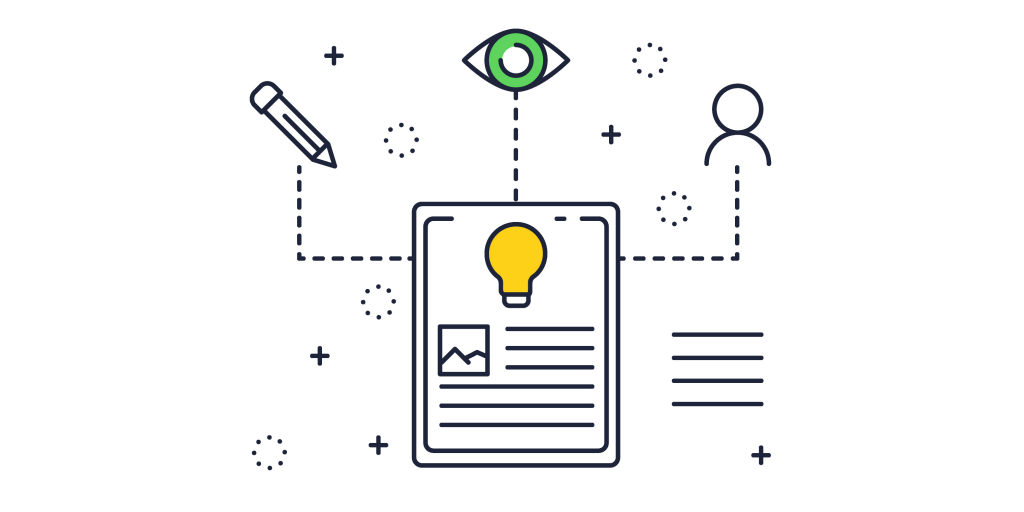So, you’ve finished the planning stages of a project, you’ve aligned the team with a single vision and the content has been developed. What’s next? You need to write a learning design brief to help your design team bring that vision to life. These 5 key tips will show you how.
Communicating your ideas to the design team is easier said than done. It can be a tricky task, especially if they haven’t been involved in the process up to now. A brief that’s too open will result in the outcome missing the target. On the other hand, a brief that is too strict will produce design that feels like it’s been built in PowerPoint.
How can you strike a balance between giving the designer direction and influencing their interpretation? Follow these guidelines on what to include in your design brief and you will.
-
Define the concept
This may seem like an obvious one, but you can’t brief someone if you don’t know what you want yourself. If you send a brief without a clear concept, the risk of multiple iterations significantly increases. That can mean potential delays to the project.
Having a clear vision for the project in your mind is one thing. Communicating it is another. Make a list or a mind map of your design ideas about a project and then distil that into a tangible plan for the overall project feel. This then gives the design team an understanding of the end goal.
You can be as succinct or specific as you like, as long as that core concept is there. That could be a one-sentence mission statement, or a larger framework of ideas, but always come back to your main design objective.
-
Know the audience
Who is the target audience of this project? Why is it being created? How will it be accessed? These are the things that will inform a designer’s decision-making and shape the project.
Looking at the target audience of the project will influence the design decisions made along the way. For example, if the project is a mobile-first scenario-based quiz, the way the interface is designed could vary considerably depending on how the audience is identified in the brief.
Are the employees generally tech proficient? Great, we can include navigation that relies on gesture-based interactions. Try that on an audience with low exposure to technology that isn’t swipe-savvy, however, and you have a recipe for trouble.
Each audience has a specific set of requirements that inform how far design boundaries can be pushed. You need to consider those requirements and communicate them to the design team in your brief.
A great way to do this is to include a profile or a biography about a fictitious character within the target audience – a kind of learner persona. Include details about their interests and preferences. Have a wider audience? Create multiple personas.
-
Be clear, be specific
Once you have established your concept for the project and given an insight into the audience it’s time to fill in the details of the main content. There are two key tenets here: be specific and be creative (one of Saffron’s key principles is ‘Straight talking, clear thinking’, and we apply that to our entire design, operations and way of being).
Make sure you include key pieces of information throughout the learning design brief to guide the design team through the project and keep their thinking aligned to the learning objectives. Including ‘stage directions’ for the designers allows them to interpret for themselves whilst staying on brief.
Being specific also mean including examples for the designers to work from, giving them more of a visual insight into your thinking. Even if you’re setting an open brief and aren’t supplying a reference, you can still be specific in the information you do give by carefully selecting the language you use and how you frame the project.
-
Select the right examples
Following on from the last point, when including examples, it’s key to include the right kind. Consider how the example will alter their interpretation of the brief. Is it making design decisions for them?
For example, if the project requires a drastic visual change from work previously produced, providing the design team with reference to an old project will influence how they approach the brief. Especially true if the two projects are working from the same brand guidelines, showing examples of how someone else has solved the problem will often result in a similar solution unless you’re clear that the example is what NOT to do.
You need to frame examples correctly. Simply giving an example of work and saying “we like this, make it like this one” will not give the designer any creative freedom. It will just restrict their ability to tailor the experience to the user resulting in bad UX.
Instead, think about why you like the example and explain how this can be applied to your project. Is it a great understanding of the user that has led to a certain functionality? Is it that the project design immerses the user from the outset? How does it do so?
An example doesn’t have to be limited to the good. A bad one can be just as useful if you highlight why it fails and how you can avoid or fix the issue. Doing this kind of deep dive in your learning design brief helps your design team out immeasurably.
-
Allow a project to develop
We’ve talked about being specific but allowing room for a project to grow is equally important. Being too specific results in a subpar project – it’s that balance we referred to in the introduction.
Walking that fine line is possibly the hardest thing about writing a learning design brief. It’s easy to get carried away with the details of how each interaction works and where you want specific things to be. Not only will this result in the design team becoming disengaged, but you also run the risk of making unforeseen issues harder in later stages of the project.
So how do you give clear instruction without making all the decisions? The answer is to break down the key things that are essential to the project, and then to supply ideas or suggestions for the secondary information that will bridge the gaps. Allow the designers to work within the concept you’ve set, and this will result in a free-flowing learning experience that feels natural to the end user.
Brief summary
To recap, the key framework for a good learning design brief is as follows:
- Have a clear concept that will become the reference point for all ideas
- Give the design team an insight into the project audience
- Be clear and specific, especially in your main content section
- Include the right kind of examples and deliver them in the right way
- Allow the project to develop without micromanagement
Finally, here’s a bonus tip. When all this is over, give feedback to your design team. We love to hear it! Come back to the brief and evaluate the design outcomes from it, giving actionable feedback.
For example, “the overall user experience of the design works well, but I think having the home button inside the burger menu will disrupt the experience by increasing the number of clicks” is much more actionable than “The user experience could be better, there are too many clicks.” Being specific will allow the designers to focus on the exact issue that you have raised, outlining a clear problem and why you are raising it as an issue.
So there we have it, you’re ready to get out there and write a learning design brief that sets your designer on track for the perfect project. What’s your best tip for briefing a design team? I’d love to hear it in the comments below.





